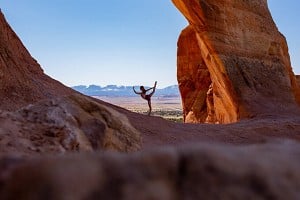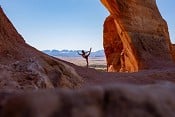
Professional dancer and keen climber Rosie Mackley shares some ballet drills that can help to improve your coordination, control, mobility and flexibility for climbing.
Perhaps some of you tried ballet as a child, while others dance around the house for fun. No matter your experience level of dance, what about using ballet specifically as a performance tool for climbing?
I was a member of the Scottish Youth Climbing Team for several years and loved going on outdoor trips too. At the same time, I enjoyed ballet lessons as an after-school hobby. However, in my teenage years, my interests shifted and I decided to pursue a career as a professional dancer, which meant that I had to give up competitive climbing, although I stayed in contact with lots of my friends in the climbing community. After graduating from the Royal Conservatoire of Scotland in 2020, the ongoing pandemic quickly caused the cancellation of my first contract for Swan Lake in an outdoor amphitheatre in Europe and left me back at home, questioning the purpose of ballet in a modern world.
One day, an old climbing friend and current Team GB athlete posted on his Instagram, joking about having the calves of a chicken! Ballet dancers have incredibly strong lower limbs from their daily training and I wondered whether this could help. Later on, he posted again about wanting to improve his box splits. Splits...ballet could help to improve that too, I thought.
The more I thought about it and chatted with him, I realised that there was this great crossover between the two disciplines. Elements such as balance, co-ordination, foot and lower limb strength, stabilisation, hip mobility, flexibility and more are crucial to both sports. Inspired by my desire to make lockdowns better for people, including myself, I decided to try running some online ballet classes designed for climbers. Thus far they have been well received and I will continue to run them for as long as they benefit climbers' performance, including the maintenance of positive mental health alongside the physical benefits.
This article provides some of my own reflections and also thoughts from others about its benefits as a means of cross-training for rock climbers, with nothing more required than something to hold on to and a little bit of space. I hope that there is a future for ballet within the climbing environment beyond the pandemic and that it will become a regular part of a training plan for any level of athlete.
One of the key benefits of ballet for climbers is to increase the movement vocabulary of climbers; to provide more possibilities for the body and therefore increase the ways in which a movement on a wall can be done. Both ballet and climbing use the body as their tools and anything to increase athletic body awareness is a positive thing. I have found it immensely helpful to shake up my typical training schedule to diversify my movement: for example, trying boxing in lockdown has taught me a lot about dynamic core stability and reaction. I think that dancing can open up new possibilities for climbers looking to be more creative with their movement. In our classes, we often begin with a single minute of what I like to call "silly dancing" – a chance just to wiggle and jump around, embracing play with no expectations, at the same time as increasing heart rate.
Another reason that ballet can be so helpful is that it utilises and relies heavily on what we call "turnout" or - anatomically - external rotation in the hip. Climbers are often encouraged to stretch these muscles in positions like pigeon or a figure four stretch, but it is rarer to strengthen the muscles that we use to rotate our legs, which is an important part of ballet training. In ballet, we operate almost entirely in this turned-out position in its various forms – usually the first, second and third positions. We use a "barre" (or chair during the pandemic) to begin with to help us keep our balance and aid the training of our turnout muscles.
One example is the plié which is how every ballet dancer's class starts – it helps with hip opening and building strength in that position. The aim is then to progress to the centre to be able to do exactly the same exercises freestanding. Ballet dancers spend many years training to be able to build this level of strength and it is proving to be a valuable tool in helping climbers to improve their hip rotation. Sore glutes have been a common complaint following our classes, but in the best possible way! These exercises in particular can easily be incorporated in a warm up. Such exercises are an opportunity to open up the hips and spine especially and are not time consuming. A variety of exercises can easily be completed within 10 minutes once the foundational knowledge has been acquired.
The typical ballet dancer is highly flexible as it is an aesthetic requirement of the sport/art. I have had to work very hard on this aspect in my own practice and am therefore able to pass on this knowledge to the participants. Ballet provides an opportunity to work on mobility in particular rather than solely flexibility: i.e. being able to actively lift your leg up high rather than kicking it there or using an external force like gravity or a hand. This ability to lift your leg and place it delicately and precisely on a hold rather than having to whack it up there gives you a much greater chance of staying on the wall. This is particularly relevant to the creative new bouldering style that is popular in competitions.
Adam Ondra has also helped to point out the benefits of ballet cross-training for foot and shin strength as well as mobility (despite also posting an April Fools video of him doing ballet training!). In one video, he works with the physiotherapist of the Czech National Ballet, which is one of the leading European ballet companies. In this video, they look at strengthening foot and shin muscles, as well as active mobility.
The overlap between the two disciplines in the field of footwear is obvious – I don't think that there are many more painful shoes out there than pointe shoes (for ballet dancers to stand on their toes) and climbing shoes. A traditional ballet class serves the purpose of building and maintaining sufficient foot and lower limb strength to withstand the load required for performing without injury. Working in socks or soft ballet shoes during a typical class therefore helps climbers to strengthen the muscles that are highly useful for accurate footwork and a 'bicycle' foot clamp position, for example.
Below are some ballet drills which transfer well to the requirements of climbing movement skills.
Plié
A slow warmup, opening the hips to the side for maximum range and control of rotation.
Glisse
A co-ordination exercise combining arms and legs. This is beneficial for core stabilisation and reducing upper body compensation while the legs are moving.
Piqué
An exercise involving core control when moving the legs in different planes, plus foot precision and spinal mobility.
Adage
A slow and sustained exercise to build strength in the hips and the muscles that allow us to lift and control our legs. This improves the capacity for more precise footwork.
Music is also something I take seriously as conditioning and stretching is a significantly more enjoyable experience if you are doing it to your favourite tune! Music also encourages use of the breath, allowing the muscles to relax into the stretch and for the body to release unnecessary tension. The use of enjoyable music has helped the climbers to have fun and feel more comfortable within a session and therefore also provides mental performance gains.
I have been delighted by the open-mindedness of the climbers who have participated in my sessions, including recreational climbers, indoor/outdoor specialists, Team GB members, youth climbers, coaches and elite level professional athletes. Alongside the sessions, I have uploaded several videos of exercises to a YouTube channel (Class 4 Climbers) for anybody to be able to access in their own time or as part of a warm-up or conditioning session.
If you would like to join in with a session, I would be very keen to hear from you and have you join the expanding group of all levels (either through Instagram @rosiemackley or via email at rosiemackley @ gmail.com). I really hope that ballet can become part of any climber's training as we move towards climbing at the walls or crags again and that you might give ballet for climbers a go!




















Comments
What a great article!
Wasn't Joyce Bracht a ballet dancer (I have a feeling she's the late Joyce Bracht)? Front cover Mountain 97, cruising up Genesis. There was an article about her then I think. 'Well developed musculature' sums her up well. I think she had a nasty abseiling accident with Coral Bowman. All going back some decades now.
In my formative years, I watched a guy soloing on Stanage with the most exquisite poise and balance. He was a ballet dancer, and it showed.
There's a great story I think from 'The Games Climbers Play' on this. Effete guy strips off his cape (really) and totally schools the regulars, Leeds Wall 80s?
One of the staff at the Boulder Hut is a relatively new climber, ex professional dancer - very fast improver. Also does a bit of online dance coaching, looks interesting.
I seem to remember this was a Dennis Gray piece?
Yes, from Slack - the fun of climbing vol 2